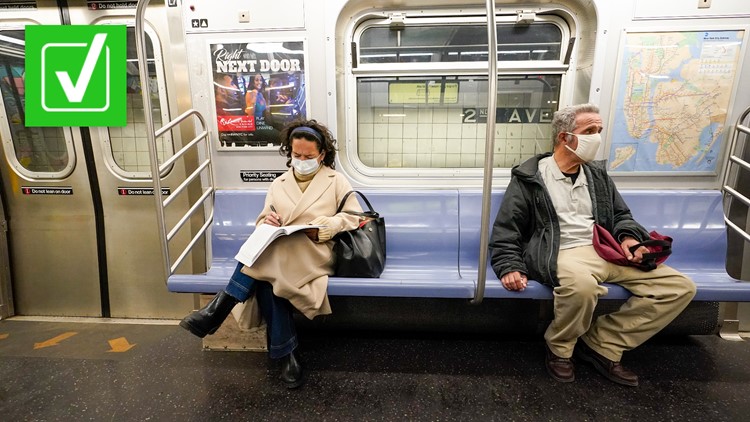UPDATE (05/03/2022): As of May 3, the CDC recommends that everyone aged 2 and older, including passengers and workers, properly wear a well-fitting mask over the nose and mouth in indoor areas of public transportation and transportation hubs.
"When people properly wear a well-fitting mask or respirator, they protect themselves and those around them, and help keep travel and public transportation safer for everyone," the CDC said.
The CDC says its recommendation is based on currently available data, including an understanding of domestic and global epidemiology, circulating variants and their impact on disease severity and vaccine effectiveness, current trends in COVID-19 Community Levels and projections of COVID-19 trends in the coming months.
-------------------------------------------------------
UPDATE (4/18/2022): A federal judge in Florida has overturned the national mask mandate covering planes and other forms of public transportation.
U.S. District Judge Kathryn Kimball Mizelle in Tampa, an appointee of former President Donald Trump, said in her 59-page ruling that the mandate exceeds the authority of U.S. health officials in the coronavirus pandemic. Mizelle also said the Centers for Disease Control and Prevention (CDC) failed to justify its decision and did not follow proper rulemaking. The CDC recently extended the mask mandate until May 3 to allow more time to study the BA.2 omicron subvariant.
The Justice Department is appealing the ruling after a request from the CDC.
-------------------------------------------------------
UPDATE (4/13/2022): The Centers for Disease Control and Prevention (CDC) announced it is extending the nationwide mask requirement for public transit until May 3. The order was set to expire on April 18.
During the 15-day extension period, CDC will assess the potential impact of the recent rise of COVID-19 cases has on severe disease, including hospitalizations, deaths, and healthcare system capacity, according to a statement from the Transportation Security Administration (TSA), which enforces the rule for planes, buses, trains and transit hubs.
-------------------------------------------------------
On Feb. 25, the Centers for Disease Control and Prevention (CDC) eased its face masking guidance for most of the United States, no longer recommending indoor mask wearing in many communities across the country. CDC director Rochelle Walensky, M.D., tweeted on March 11 that more than 98 percent of the U.S. population is currently in a location with low or medium COVID-19 community levels.
The CDC’s updated guidance did not change the federal mask mandate on public transportation, which was first issued by President Joe Biden on Jan. 21, 2021, and extended three times by the Transportation Security Administration (TSA), which enforces the rule. But online searches show many people are still wondering if they have to continue masking on airplanes and other forms of public transit.
THE QUESTION
Do I still have to wear a mask on planes, trains and other forms of public transit?
THE SOURCES
THE ANSWER
Yes, the CDC recommends mask-wearing on planes, trains and other forms of public transit.
WHAT WE FOUND
At the CDC’s recommendation, the Transportation Security Administration (TSA) extended the federal mask mandate on planes, buses, trains and other forms of public transportation, as well as in transportation hubs, through May 3, the federal agencies confirmed in a statement.
So what does this mandate mean for you? The VERIFY team answers your questions below.
Where are face masks required?
Under the current federal mandate, face masks are required to be worn by all people, regardless of their vaccination status, while on public transportation traveling into, within, or out of the U.S. and U.S. territories.
The order also requires everyone to wear masks while at transportation hubs, such as airports, public bus or ferry terminals, train and subway stations, seaports, U.S. ports of entry, and all other locations where people board public transportation in both indoor and outdoor areas.
Where are face masks not required?
People who are eating, drinking, or taking medication for brief periods of time are not required to wear a mask while in indoor transportation areas. Wearing a mask is also not required while communicating for brief periods of time with a person who is hearing impaired when the ability to see the mouth is essential for communication, as well as under the following circumstances:
- if, on an aircraft, wearing oxygen masks is needed because of loss of cabin pressure or other event affecting aircraft ventilation
- if unconscious (for reasons other than sleeping), incapacitated, unable to be awakened, or otherwise unable to remove the mask without assistance
- when necessary to temporarily lower or remove the mask to verify one’s identity, such as during a TSA screening or when asked to do so by the ticket or gate agent or any law enforcement official
- when experiencing difficulty breathing or shortness of breath or feeling winded, until able to resume normal breathing with the mask; when vomiting until vomiting ceases; or if wearing a mask interferes with necessary medical care such as supplemental oxygen administered via an oxygen mask
People onboard the following categories of transportation also continue to be exempt from the requirement to wear a mask:
- Private forms of transportation operated only for personal, non-commercial use
- Commercial motor vehicles or trucks, if the driver is the only person in the vehicle or truck, or the vehicle or truck is operated by a team who all live in the same household and are the only persons in the vehicle
- Forms of transportation operated or chartered by the U.S. military as long as the operator of the conveyance follows all requirements of U.S. military services to prevent the spread of COVID-19 that are equivalent to the requirements in CDC’s order.
Are face masks required on school buses?
The CDC no longer requires people to wear masks on buses or vans operated by public or private school systems, including early care and education/child care programs. The CDC said on Feb. 25 that it made this change to align with guidance that no longer recommends universal indoor mask wearing in K-12 schools and early education settings in areas with a low or medium COVID-19 community level.
School systems may choose to require that people wear masks on buses or vans at their discretion, the CDC said.
Who is exempt from wearing a face mask?
Children under the age of 2 years old are exempt from wearing a face mask on public transportation, according to the current mandate.
A person with a disability who cannot wear a mask, or cannot safely wear a mask, because of the disability as defined by the Americans with Disabilities Act is also exempt from the mandate, along with “a person for whom wearing a mask would create a risk to workplace health, safety, or job duty as determined by the relevant workplace safety guidelines or federal regulations,” according to the CDC.
For more information on the federal mask mandate on public transportation, visit the CDC’s website.
The Associated Press contributed to this report



